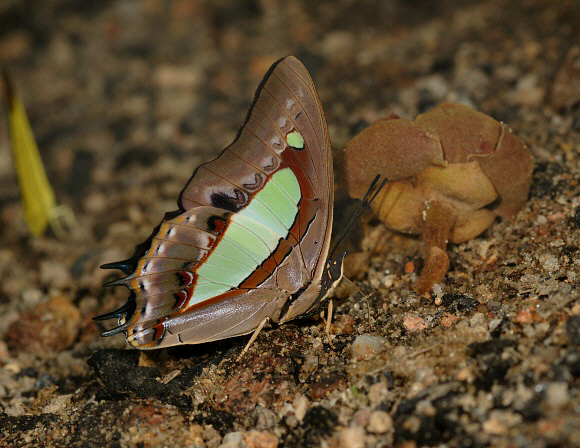
Introduction
There are 24 species in the genus Polyura, most of which are found in the Oriental region, although one species, posidonius, is restricted to Tibet and west China. Additionally, there are 6 or 7 species endemic to various islands, e.g., andrewsi from Christmas Island and caphontis from Fiji; and one, pyrrhus, which reaches Queensland in Australia.
The butterflies are characterized by their distinctive wing shape with twin tails on the hindwings, a feature shared with Charaxes, within which Polyura is included by some workers. Polyura species generally have dark brown uppersides, with bands of creamy white which vary in size and shape according to species. These bands are repeated on the underside, usually in a beautiful shade of pale green. In a few species such as delphis, the underside is almost entirely white.
There are 8 species occurring in India – athamas, arja, schreiber, moori, narcaeus, delphis, dolon, and eudamippus.
Polyura athamas is the commonest and most widely distributed species. It is found in India, Nepal, Sri Lanka, Bhutan, Tibet, Myanmar, Thailand, Malaysia, Vietnam, China, Laos, Cambodia, Taiwan, Brunei, Kalimantan, the Philippines, Sumatra, Sulawesi, Java, Lombok, and Timor.
Habitats
This species is found in forested areas at elevations between sea level and about 800 meters.
Lifecycle
The egg is spherical, shiny, and yellow. It is laid on the underside of leaves of the foodplants. The larva when fully grown is dark green with 3 prominent white diagonal stripes, and several thinner stripes, all of which converge on the back to form a series of V shapes. It has a large head with a flat face, adorned with a crown of 4 impressive long horns. It feeds nocturnally on the foliage of various trees and shrubs including Albizia, Acacia, Abarema, Adenanthera, Delonix, Peltophorum, and Leucaena (Fabaceae), Grewia (Malvaceae), and Caesalpinia (Caesalpinaceae). The plump rounded pupa is green, streaked with white on the abdomen and wing cases. It is attached by a stout pedunculate cremaster to a twig or stem on or near the foodplant.
Adult behaviour
Females are rarely seen and probably spend most of their lives in the forest canopy, but males are common and often seen imbibing mineralized moisture from damp sand, gravel, or road surfaces. Often 2 or 3 athamas or other Polyura species can be found aggregating at dung or carrion. When feeding, the butterflies are almost oblivious of humans. If deliberately disturbed they fly up rapidly to settle on tree foliage nearby, but return as soon as they sense danger has passed.
